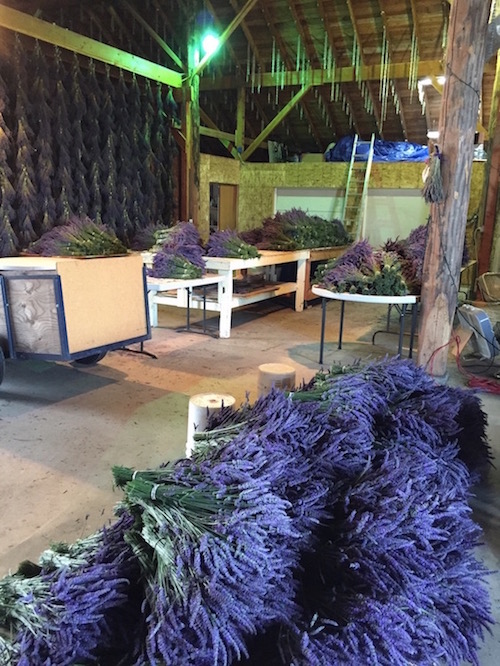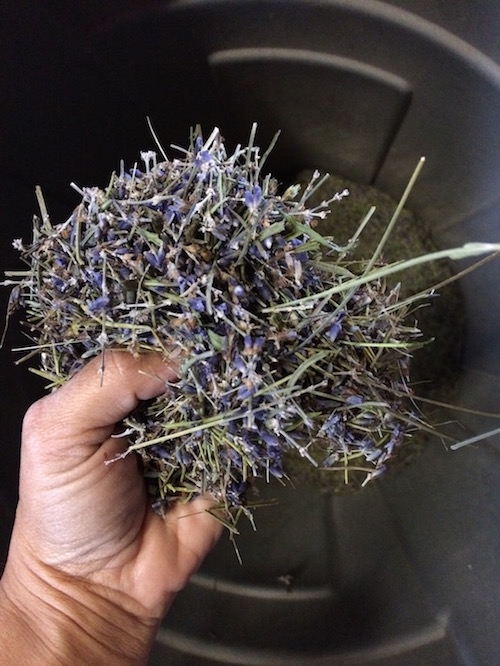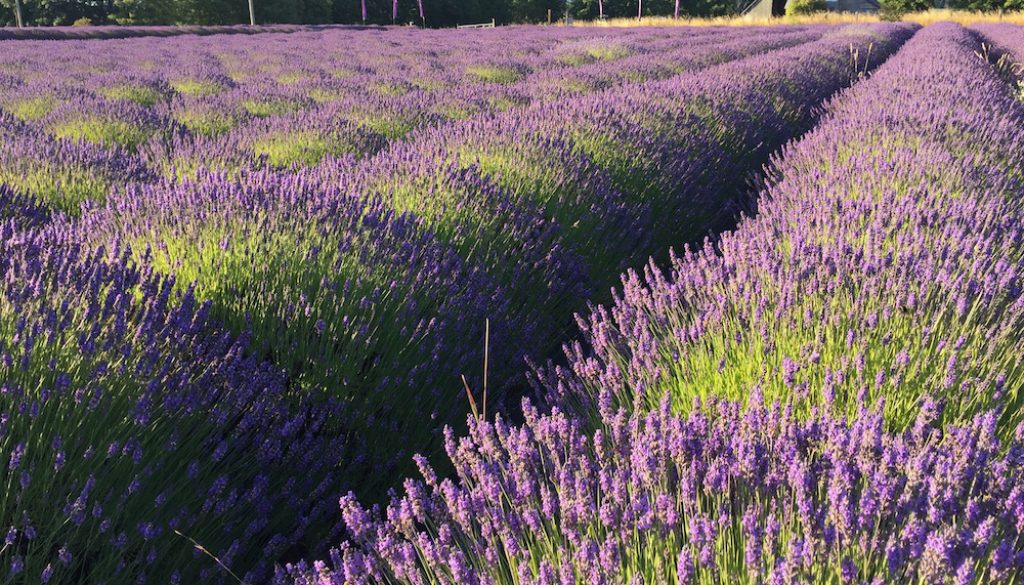
Lavender Arrives in the Olympic Peninsula
Not long ago, lavender, a new and rather unexpected agricultural crop, came to the Olympic Peninsula of Washington. Well-known for its torrential rainfall and perpetually overcast skies, the Olympic Peninsula seems an unlikely place to grow such a fussy shrub. After all, lavender is averse to moist soil and flourishes in warm, dry climates with full sun. In most of the Olympic Peninsula, lavender would have no chance, but there is a town on the Peninsula that is the exception to the rule in terms of weather: Sequim.
Sequim, (pronounced “Skwim”), enjoys a warm, relatively dry microclimate on the otherwise rain-soaked Pacific Northwest. Sequim sits in what climatologists refer to as a “rain shadow.” The Olympic Mountains to the South are so tall that rain clouds coming in from the Pacific Ocean dump the vast majority of their water before they reach Sequim. The phenomenon is so pronounced that you can literally look around you in Sequim when there is rain in the area and see a horseshoe shape of precipitation around the city.
Although the mountains block the rain from the Pacific Ocean, Sequim’s proximity to the Pacific means that the weather remains fairly constant throughout the year. Sequim usually stays above freezing throughout the winter months – a critical factor for successful lavender farming.

THE ARRIVAL OF LAVENDER IN SEQUIM
In the 1990’s lavender farming made its debut in Sequim, as famers there were eager to diversify their crops. Sequim’s unusual microclimate matched up with a handful of other areas around the globe where lavender grew well. It turned out that the soil, not being too rich in nutrients, was also a good match. When this connection was discovered, it didn’t take long for lavender farming to take hold.
B & B FAMILY FARM
Among the farms that converted to lavender during that era was a 100-year old dairy farm known as Angel Farm. In 2013 the original owners sold their farm to four new owners: Bruce and Bonnie McCloskey, their daughter, Kristy, and husband, Zion Hilliker. The decision of the family to purchase the farm was part of a larger plan to relocate near to their other daughter, Amy, who had recently moved to the area.
The family renamed the farm “B & B Family Farm” and got to work. Having four business owners can be a challenge. In this case, however, it proved to be an asset as each owner brought a unique set of skills to the table. Collectively, they have made the farm into a thriving family business.

Kirsty, with a master’s degree in Interior Design, works on everything from the farm’s website and social media to the decor and display of the on-site gift shop. Her husband, Zion, who has a background in sustainable farming, serves as the master gardener. Father, Bruce, makes good use of his accounting and handyman skills to keep everything from the financials to the equipment running smoothly. His wife, Bonnie, is the mastermind and craftsperson behind many of the goods for sale in their gift shop.
There is a third generation of the family at the farm. Although they are still a bit young to be productive, their presence adds an innate cuteness to the photos on their website. More importantly, their photos serve as a reminder that in some niches, small family farms in the US survive despite the rise of colossal agribusiness.
THE SCENT OF LAVENDER
Taking a tour of the B & B Family Farm is an amazing experience for your olfactory system. You can smell the lavender from the edge of the farm, and if you happen to visit during harvest season it can be quite intense the nearer you get to the barn where the lavender is dried. With such a relaxing aroma filling the air, you quickly begin to unwind during your visit.
Probably first used as a perfume due to its remarkable scent, lavender has found its way into current culture as an additive in bath and laundry products, as well as beauty aids. Historical records tell us that lavender has been used for millennia, with written records of its use dating to Ancient Greece and Rome. Perhaps best known for its sedative effects, lavender has been used to treat skin ailments such as burns and abrasions, and it has been widely utilized as an insect repellent.
HOW LAVENDER GROWS
Lavender is a bushy type of shrub that tends to grow in clumps. The shrubs are planted in long rows that sometimes are mounded up to ensure good drainage for the roots.
The plants are propagated from 3” cuttings from mother plants which are not very old. This is because as the plants age, their stems become shorter, more woody, and they produce less oil. Older plants can still be used to produce lavender bud, but the shorter stems mean that they are no longer suitable for sale as bouquets.

After about 15-25 years, depending on the variety of lavender, the plants must be ripped out and planted from scratch. Newly planted lavender takes approximately a year to reach maturity, so harvesting can be done the year after planting.
Growing lavender from seed is possible, but the germination cycle is challenging to get just right, so there is a lot of effort involved. Furthermore, the purity of the strain of lavender seed is an issue, so almost all new growth is done through propagation to ensure the right variety is planted.
HARVESTING LAVENDER
Lavender can be used in a variety of ways, and the way in which it will be used determines the correct time to harvest it. Harvest times are governed by the percentage of buds on the plant that have bloomed.

To harvest lavender, bunches are gathered together by hand and cut with a hand-held sickle approximately 2” above where the stem has become woody.
The bunches are bundled with rubber bands and piled onto a wagon to transport them out of the field.


Dried lavender bud is obtained from the first round of cutting. This occurs when approximately 5% of the buds have opened. The second harvest is performed when 10-20% of the buds have flowered. These cuttings are sold for fresh bouquets and are shipped immediately throughout the US and Canada. When the lavender has reached full bloom, a final round of harvesting is used to produce essential oil.
DRYING LAVENDER
Any lavender that will be used in dried bouquets or for bud is taken to the barn at B & B Farm. There a team of people unloads the fresh-cut lavender from the wagons. Paper clips are then passed through the rubber bands binding each of the bunches together. Next, the paper-clipped bunches are hauled up a ladder to the rows of chains that dangle from the top of the barn. Each bunch is hung from these chains with enough space for air to circulate so that they can dry quickly.

In approximately 2-3 weeks, depending on the temperature and humidity, the bunches are removed one at a time in an equally labor-intensive process. These dried bunches are either used to produce lavender bud or they are sold as dry bouquets.
PREPARING LAVENDER BUD
Lavender that will be sold as bud first must be removed from the stem of the plant. Once that has been done, it is still necessary to separate the remaining chaff from the bud.
To de-bud the stems, brushes are typically utilized, although some farms use rubber finger-like mechanisms for this task. Some small lavender farms use an older, entirely manual method involving wire screens to de-bud the stems and filter the bud.

At B & B Family Farm they use a custom-built device that has two spinning chimney brushes. When the lavender bunches are thrust in between the brushes, the bud is knocked off and falls into a bin below. The remaining stems are then discarded.

While quite effective at removing the bud from the stem, the chimney brush method leaves a lot of residual plant matter that has to be removed in a secondary process. B & B is fortunate enough to have a modified seed-sorting machine known affectionately as the “Jitter Bud” which accomplishes this last step with extreme efficiency.

The mixture of bud and chaff churned out by the chimney brush machine is fed into the top of the Jitter Bud 30 lbs at a time. The assorted bits and pieces are bounced and shaken over progressively smaller screens as they descend through the machine.
When all is said and done, there remains only lavender bud in the plastic bins at the end of the Jitter Bud.

What didn’t pass muster ends up in separate collection containers that are carried out to fallow fields where their contents are used as fertilizer.
PRODUCING LAVENDER ESSENTIAL OIL
Lavender essential oil is well-known for its soothing properties. It has applications in aromatherapy and as a topical agent in alternative medicine. Over the last couple of decades it has gained significant popularity in the United States, and is now the most popular essential oil on the market.
In order to extract the essential oil, parts of the lavender plant are put through a process of steam distillation. Steam distillation is commonly employed in everything from alcohol production to the petrochemical industry because it can extract organic compounds that are heat sensitive.
The process of distillation for lavender essential oil happens in a special copper still at B & B. The copper binds with the stinky sulfur produced during distillation and keeps it out of the final product.
Green stems with buds from 6-12 full lavender plants (it takes a whole lot) are added together with a little water. Steam is then passed through the tightly packed plant material and carries the oil over to a tube that passes through a cooling tank.
The condensed product which contains both oil and water (a product known as hydrosol) then drips out of the bottom of the tube into a collection cup.

The oil floats on top of the water, so the water is drained out of the bottom of the collection cup, leaving only the oil that is then drawn off into a separator funnel.
Finally, the extracted oil is run through a metal coffee filter to remove any particulate matter remaining. What passes through the filter is the essential oil that is bottled and sold.
B & B Farm does its distillation on site. They may be working on some when you stop by and they will be happy to explain the process.
WHY YOU SHOULD VISIT B & B FAMILY FARM
There are currently 9 lavender farms in Sequim, and certainly they all have something to offer. B & B Family Farm distinguishes itself by focusing on educating people who are interested in lavender. Many of the farms offer educational opportunities for a small fee, but B & B thinks that it should be a free service. At B & B, they will literally take time out during the busy harvest season to show you around and teach you all about lavender because they feel educating the consumer is that important.
Bruce McCloskey, co-owner, knows that the more that the public learns about their product, (e.g. how it is grown or uses for lavender that they did not yet know about), the more apt they will be to buy lavender in the future. “That helps us all,” he says. He acknowledges all of the lavender visitors buy won’t come from B & B Farms. But, he knows that by developing a solid customer base, B & B is supporting the industry as a whole, and that is critical for all lavender farmers.
B & B specializes in growing lavender that is used for culinary purposes. So, if you are someone who cooks with lavender or you know someone who does, this is the perfect place to get some oil or lavender bud. Lavender is used in making specialty vinegars, baked goods, fancy cocktails, and gourmet sugar – just to name a few things.
The 12 varieties and over 7,000 plants on the farm also can be used for alternative medicinal purposes. Lavender can provide headache relief and soothe the digestive tract. If you’ve heard of using lavender for these purposes and you are interested in trying them, B & B grows the kinds you need.

THE LAVENDER CAPITAL OF NORTH AMERICA
Over the last couple of decades, lavender has become nearly synonymous with Sequim. Since lavender farming began in the region it has had a tremendous impact on tourism. Like so many other lavender farms around the US, the lavender farms in Sequim rely a great deal on agro-tourism.
As such, many of the larger lavender farms have a notable retail presence in town. Set up with commercial kitchens, lavender retail stores cook up lavender cookies and serve lavender ice cream. Their storefronts are filled with displays in every possible shade of lavender.
You cannot walk through downtown Sequim without thinking about lavender. In addition to the ubiquitous lavender stores, the City of Sequim identifies itself with the color purple. There are purple signs and park benches, and the city is now billing itself as the “Lavender Capital of North America.”

Each July there is a Lavender Festival that gets bigger every year. During this time most of the local farms are open for tours so you can see the lavender in their fields in full bloom, and you can learn about how they process what they grow.
Sequim is located just off of Highway 101, also known as the Olympic Loop. If you plan to visit Olympic National Park, you will likely be driving by Sequim and the B & B Family Farm. Take some time to stop and learn a little about lavender farming at B & B and get some locally made goodies to bring back to friends and family.
B & B is open daily from 9 AM to 5 PM during tourist season, (May through September) . Bruce, Bonnie, Kristy, Zion, and the kiddos would love to give you a tour and show you what makes lavender farming such an exciting family business.




